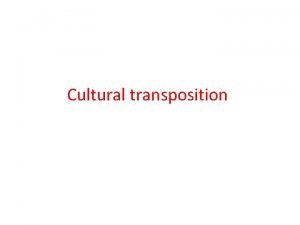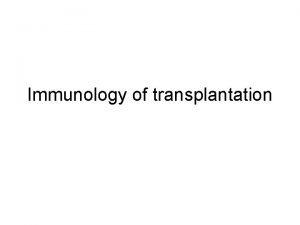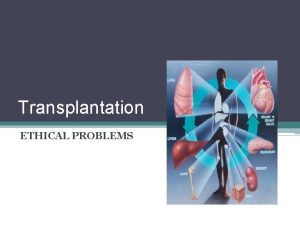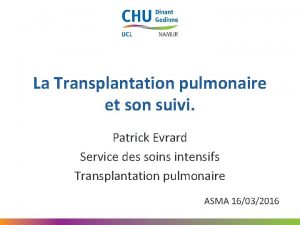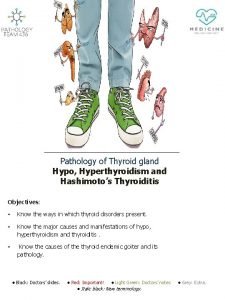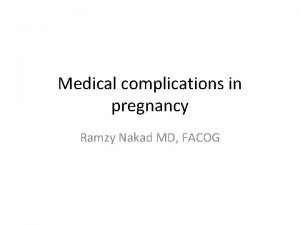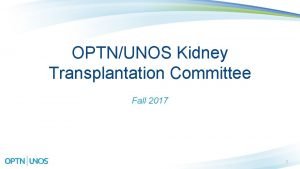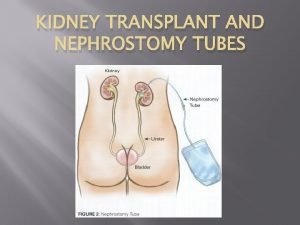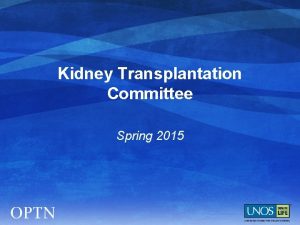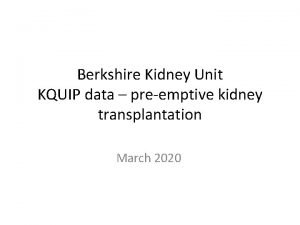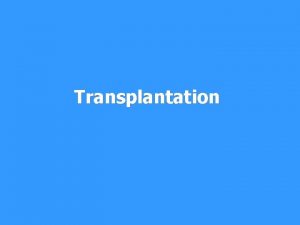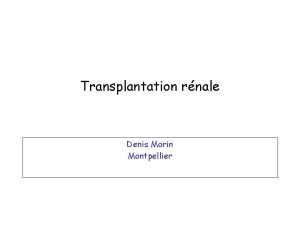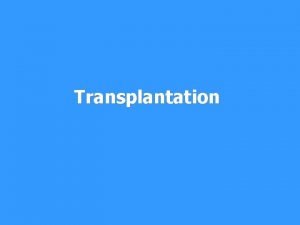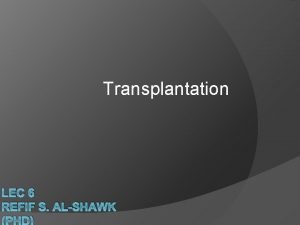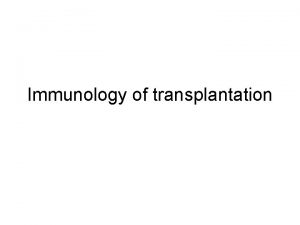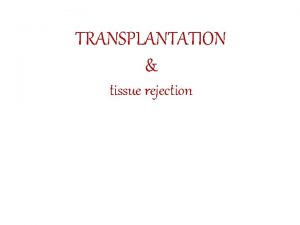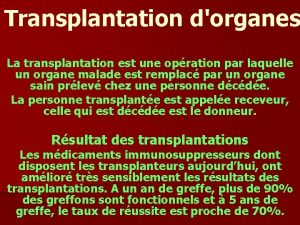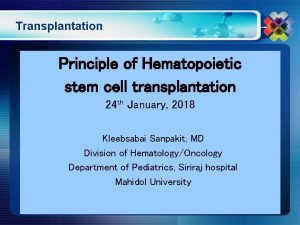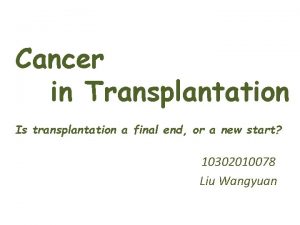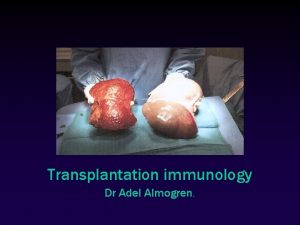722 KIDNEY TX KIDNEY TRANSPLANTATION WOMEN IN KIDNEY













































- Slides: 45

722 KIDNEY TX KIDNEY TRANSPLANTATION WOMEN IN KIDNEY TRANSPLANTATION ULKEM CAKIR, MD PROFESSOR OF MEDICINE/NEPHROLOGY

Outline • What is chronic kidney disease? • Why kidney transplantation? • Who is a kidney transplant recipient candidate? • Timing? • Donor source? • Pretransplant evaluation? • Posttransplant follow-up? • Prognosis? • Women in kidney transplantation

What is chronic kidney disease (CKD)? • Irreversible damage in both kidneys • • Characterized by disorders in structural and functional abnormalities Lasts more than 3 months Glomerular filtration rate (GFR) decreases eventually Can be diagnosed by blood, urine and imaging studies

CKD-Staging

Approach to CKD Stage GFR (m. L/min/1. 73 m 2) Approach 1 90 Diagnosis/monitoring progression 2 60 -89 Slowing progression 3 30 -59 Detection and treatment of the complications 4 15 -29 Preparation for renal replacement therapy 5 <15 Renal replacement therapy

Renal replacement therapies (RRT) • Hemodialysis • Peritoneal dialysis • Kidney transplantation

First kidney transplantation in the world 1954 Prof. Joseph E. Murray Nobel Prize (1990)

First kidney transplantation in Turkey Prof. Mehmet Haberal • • 1975 Living-related 1978 Cadaveric

Kidney transplantation in Turkey 2010: 2500 2011 -2012 -2013 -2014 -2015: 3000

Why transplantation? • • Gold standart in treatment of ESRD Better quality of life Better life expectancy Lower cost

RRT-Mortality • • • Dialysis: 6. 3% / year Kidney tx from a cadaveric donor: 3. 8% / year Kidney tx from a living donor: 2% / year

Cost of renal replacement therapies (USD/ year) * - Hemodialysis 22 644 - Peritoneal Dialysis 22 350 - Kidney Tx (1) 23 393 - Kidney Tx (2) 10 028 *Erek E et al. NDT, 2002.

Life Expectancy (Years) AGE HEALTHY PERSON DIALYSIS PATIENT RENAL TX PATIENT

Who is a kidney transplant recipient candidate? Everyone who has been diagnosed as ESRD should be evaluated for kidney transplantation

Contraindications to kidney transplantation (? ) • Severe cardiovascular and peripheral vascular disease* • Active infection • Malignancy* • HIV* • Drug addiction • Insufficient social support • Insufficient financial support

Timing? The sooner the better…

Timing? The sooner the better…

Preemptive kidney transplantation • Positive impact on patient and graft survival • The rate of preemptive kidney tx in USA – – • Living: %25 Deceased: %7 -8 In Turkey: % 20

Donor source • Deceased • Living – Related-Paired – Unrelated

Living kidney transplantation • • Waiting lists inrease enormously Insufficient cadaveric donation

Advantages of living kidney transplantation • Timing of the operation • Optimal evaluation of the recipient and donor • Better short and long term results

Relationship between donor and recipient Related Patient/ Patient’s wife’s relatives 1. Degree : Father, Mother, Children 2. Degree : Brother, Sister, Grandfather/mother 3. Degree : Uncle, Aunt, Nephew, Niece 4. Degree : Children of 3 rd degree

Relationship between donor and recipient Related-Paired Kidney paired donation (KPD) is a transplant option for candidates who have a living-related donor who is medically able, but cannot donate a kidney to their intended candidate because they are incompatible.

Paired Kidney Transplantation DONOR 1 (A) DONOR 2 (B) RECIPIENT 1 (B) RECIPIENT 2 (A)

Relationship between donor and recipient Unrelated Candidates who have a living-unrelated donor who is medically able, but the legal procedure should be investigated by 'Local Ethical Commitee of Ministry of Health'

Pretransplant evaluation • Potential contraindications • Basic immunological studies • Expected success rate

Evaluation for kidney transplantation-I • Examination of documents by organ coordinators (legal procedure) • Evaluation by Nephrology • Evaluation by Surgery • Immunologic evaluation ( HLA antibodies, Cross Match)

Evaluation for kidney transplantation-II • Routine Laboratory Tests • Radiologic Imaging • Consultations

Blood type and tissue matching • • Blood type matching is still a must. We need tissue typing only for deciding which type of the immunsuppression protocol to use.

Blood Type Matching O BLOOD TYPE AB BLOOD TYPE A BLOOD TYPE

Contraindications for donation? • • • Infection and cancer Every donor candidate has to be evaluated by the transplant team(s) in order to avoid rejecting due to wrong reasons We need every organ in such donor shortage

Women in Kidney Transplantation As Donors-Courage in Donation One of the greatest barriers to a receiving a living-donor transplant is difficulty in asking others to donate a kidney. Patients are often concerned that family and friends will be angry with them for asking, they feel they will be bothering their family members, or they have concerns that they will be jeopardizing the health of others by asking for them to donate a kidney. Women are better at asking others to donate to a loved one as opposed to asking someone to donate a kidney on their own behalf.

Kidney Transplantation As Donors-Surgical Approach Being associated with similar graft function, a similar graft loss rate, similar surgical complications, similar graft survival and a similar mortality rate while having significantly lower analgesic use, a quicker recovery, and a shorter hospital stay than open nephrectomy, laparoscopic living-donor nephrectomy (LLDN) has been widely accepted as a goldstandard method for kidney procurement.

Women in Kidney Transplantation As Donors-Surgical Approach Minimally invasive new laparoscopic techniques, such as natural orifice transluminal endoscopic surgery (NOTES) and laparoendoscopic single-site surgery (LESS), have recently been described as aiming at reducing morbidity further by avoiding surgical incisions and external scars. Transvaginal natural orifice transluminal endoscopic surgery– assisted living-donor nephrectomy seems to be a feasible and reproducible alternative to conventional laparoscopic livingdonor nephrectomy in female donors provided the viability of the vagina as an organ retrieval route.

Kidney Transplantation Operation • Donor operation • Recipient operation

Donor Operation Open Surgery (Donor Nephrectomy)

Donor Operation Laparascopic Surgery (Donor Nephrectomy)

Donor Operation Laparascopic Surgery (Transvaginal Donor Nephrectomy)

Donor Operation Peroperative Postoperative 1 st month Laparascopic Surgery (Single Port Transvaginal Donor Nephrectomy)

Recipient Operation

Recipient Operation

Prognosis Graft survival rates for 1 year change from 80 to 95%

Acibadem University International Hospital Transplant Center • • Kidney transplant program (Oct 11, 2010) 722 transplants (98% living donor) Female Donors: 415 Female Recipients: 223

Acibadem University International Hospital Transplant Center • • Kidney transplant program (Oct 11, 2010) 722 transplants (98% living donor) Graft survival rate: 99% 1 st year, 94% 5 th year Patient survival rate: 99% 1 st year, 95% 5 th year

KIDNEY TRANSPLANTATION WHY US? 722 KIDNEY TX Ethics & Academical environment Internationally approved and experienced transplant team High standards in medicine Plasmapheresis for highly sensitized patients Laparascopic donor nephrectomy, transvaginal route for women
 Ist 722 github
Ist 722 github Ssis-722
Ssis-722 Grammer 722
Grammer 722 Kingdom chapter 722
Kingdom chapter 722 Grammar
Grammar Cultural transposition
Cultural transposition Bone marrow transplantation sri lanka
Bone marrow transplantation sri lanka Transplant
Transplant Law of transplantation
Law of transplantation Stem cell or bone marrow transplantation bangkok
Stem cell or bone marrow transplantation bangkok Patrick evrard transplantation
Patrick evrard transplantation Shaalvim for women
Shaalvim for women 1900 children's clothing
1900 children's clothing Women empowerment points
Women empowerment points Women computer science
Women computer science Trichomoniasis symptoms discharge
Trichomoniasis symptoms discharge Unity women's desk
Unity women's desk Small scale industries
Small scale industries National agencies related to child welfare
National agencies related to child welfare God comes to women
God comes to women Women height bell curve
Women height bell curve Thyroid symptoms for women
Thyroid symptoms for women Child rights
Child rights Pornography: men possessing women
Pornography: men possessing women Hypothyroidism
Hypothyroidism Stardoll presentation backgrounds
Stardoll presentation backgrounds Paradigm shift from women studies to gender studies
Paradigm shift from women studies to gender studies Discreetfunpartner
Discreetfunpartner White men are saving brown women from brown men
White men are saving brown women from brown men Physical violence against women
Physical violence against women Women's volleyball net height in feet
Women's volleyball net height in feet Introduction to women empowerment
Introduction to women empowerment Women entrepreneurs statistics
Women entrepreneurs statistics Cervicitis slideshare
Cervicitis slideshare Women of woodside
Women of woodside Cauvery college for women
Cauvery college for women Two female pronouns candy
Two female pronouns candy Higher history women's suffrage essay
Higher history women's suffrage essay Mujaheen
Mujaheen Nn women
Nn women Business professional dress for women
Business professional dress for women Gcse box plot questions
Gcse box plot questions Women's ministry goals and objectives
Women's ministry goals and objectives Economic activities by men and women
Economic activities by men and women Nara women’s university
Nara women’s university Ad
Ad





